Costa Rica's Favorite Meal: The Casado
February 7, 2025
Costa Rica is a fabulous destination for luxury travelers, as well as seniors, couples, and families, not least because of its many excellent dining options.…
Read This Post Although no longer the seat of a large empire, Rome is still one of the culinary capitals of the world, home to centuries-old culinary traditions. If you head to the Eternal City on one of our culinary vacations in Italy, you can try famous Roman dishes throughout Rome’s many neighborhoods.
Although no longer the seat of a large empire, Rome is still one of the culinary capitals of the world, home to centuries-old culinary traditions. If you head to the Eternal City on one of our culinary vacations in Italy, you can try famous Roman dishes throughout Rome’s many neighborhoods.
There are many food places in Rome, from Michelin-starred restaurants to bakeries to snack bars. So what is the true food of Rome? What are the best, most authentic dishes to eat?
While our culinary vacations in Italy include most of your meals, our travelers usually like to have one or two meals to explore on their own. Sometimes this is because they want a lighter meal, sometimes it is to satisfy their adventurous spirit! For this reason, and because many of our culinary travelers to Italy like to do pre- or post-nights in Rome, we have compiled the ultimate guide to the food of Rome.

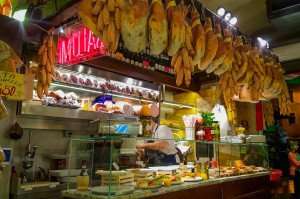 How to Eat Food in Rome – Travel Tips
How to Eat Food in Rome – Travel Tips
See all of our cooking classes and food tours in Rome.
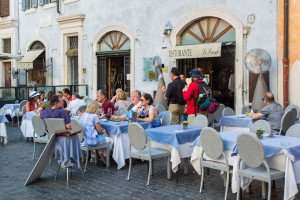 When you head out to try the local food in Rome during our Roman culinary vacations, you may be confused by the different types of restaurants. Among your many choices are the following:
When you head out to try the local food in Rome during our Roman culinary vacations, you may be confused by the different types of restaurants. Among your many choices are the following:
 trattoria – This was originally a sit-down eatery where you could grab a casual and inexpensive meal. They still tend to be more casual than a ristorante, often with classic Roman food and drink (and wine served in carafes). Trattorie traditionally offer a menu of daily specials.
trattoria – This was originally a sit-down eatery where you could grab a casual and inexpensive meal. They still tend to be more casual than a ristorante, often with classic Roman food and drink (and wine served in carafes). Trattorie traditionally offer a menu of daily specials. The countryside around the capital city offers equally fascinating culinary traditions. In hills outside of Rome, known as the castelli romani you can find small fraschette, a sort of combination of modest restaurant and delicatessen. These fraschette have their origins in medieval (and some say even ancient) times, and still specialize in such regional staples as porchetta (a stuffed, boneless pork roast sliced and served cold), local charcuterie and cheese, and of course local wine, which is poured off from great barrels into liter, half-liter, or quarter-liter carafes. Frequently boasting long tables, the experience gives one the feeling of having a communal indoor picnic with one’s fellow diners.
The countryside around the capital city offers equally fascinating culinary traditions. In hills outside of Rome, known as the castelli romani you can find small fraschette, a sort of combination of modest restaurant and delicatessen. These fraschette have their origins in medieval (and some say even ancient) times, and still specialize in such regional staples as porchetta (a stuffed, boneless pork roast sliced and served cold), local charcuterie and cheese, and of course local wine, which is poured off from great barrels into liter, half-liter, or quarter-liter carafes. Frequently boasting long tables, the experience gives one the feeling of having a communal indoor picnic with one’s fellow diners.
 Based as it is on hearty peasant food, many authentic Roman dishes are, unsurprisingly, based on pasta and meat. As in all of Italy, the meal is divided into antipasti, primi, secondi, contorni, and dolci. The antipasti are appetizers or starters, which can be elaborate if ordered in a restaurant, but are often a plate of salumi or prosciutto, classic bruschetta, or fried foods. The primi are pastas and soups or, more rarely, rice (which is more popular in the north). These popular Roman dishes are some of the most iconic: think of rigatoni alla carbonara, that authentic Roman dish made with guanciale and egg.
Based as it is on hearty peasant food, many authentic Roman dishes are, unsurprisingly, based on pasta and meat. As in all of Italy, the meal is divided into antipasti, primi, secondi, contorni, and dolci. The antipasti are appetizers or starters, which can be elaborate if ordered in a restaurant, but are often a plate of salumi or prosciutto, classic bruschetta, or fried foods. The primi are pastas and soups or, more rarely, rice (which is more popular in the north). These popular Roman dishes are some of the most iconic: think of rigatoni alla carbonara, that authentic Roman dish made with guanciale and egg.
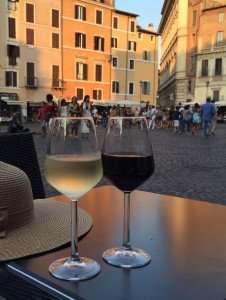 The secondi are meat and fish dishes. Lazio, the region in which Rome lies, has many lakes and a long coastline, but the most common fish is probably baccalà, or salt cod. Still, meat is more common than fish on most Roman menus, and offal is one of the most popular Roman dishes.
The secondi are meat and fish dishes. Lazio, the region in which Rome lies, has many lakes and a long coastline, but the most common fish is probably baccalà, or salt cod. Still, meat is more common than fish on most Roman menus, and offal is one of the most popular Roman dishes.
The secondo is usually served with a vegetable or salad, called the contorno. And of course, the meal is finished with a dolce, dessert. This last is usually accompanied by a coffee (always espresso, never cappuccino), and a digestivo (after-dinner cordial).
Worried about eating that much on our Roman culinary vacations? Trust me, you’ll manage! But there is also no rule that you have to order every course.
What more information on Rome? Check out our Tips for Visiting St. Peter’s Basilica.
Now that we’ve covered the basics, what are the most popular Roman dishes that you will find on our culinary vacations in Rome?
Each Italian region has its own special shapes of pasta and its own ways of dressing them, and Rome is no different.
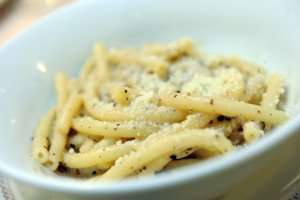 Cacio e Pepe
Cacio e PepeOne of the most classic Romana pasta dishes is cacio e pepe. The name says it all: it is a pasta dressed with a type of sheep’s-milk cheese called cacio and black pepper. So simple, yet so delicious. Sometimes a bit of parmigiano is used as well, and some of the pasta water makes the sauce creamy, but a plate of cacio e pepe is one of the simplest and most authentic of Roman pasta dishes.
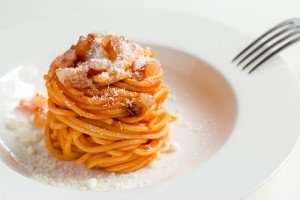 Amatriciana and Gricia
Amatriciana and GriciaOne of my favorite Roman pasta shapes is bucatini, a type of thick spaghetti with a hole running down the middle of it. It is usually dressed with a classic amatriciana sauce or alla gricia. This last is a type of “white amatriciana.” The traditional amatriciana is made with guanciale (think bacon, but made from pork cheek) and tomato, then topped with pecorino cheese, but the gricia version leaves out the tomatoes.
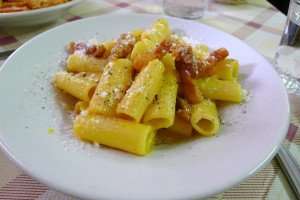 Carbonara
CarbonaraThere is little consensus on how carbonara was invented, but it is undoubtedly the most famous of classic Roman pasta dishes. You can make it with any pasta shape, but the key is once again in the simplicity, using only guanciale, egg, and cheese (usually pecorino). You will sometimes find carbonara recipes with cream, but that is a foreign addition. The creaminess comes from the method of preparation. (See our recipe for carbonara.)
Where can you get these amazing pastas on a culinary vacation in Rome? Try Pommidoro, one of our favorite eateries in the off-the-beaten-path San Lorenzo neighborhood. (The food is worth the trip, but the restaurant is also where Italian author and filmmaker Pier Paolo Pasolini had his last meal before his murder in 1975.)
If you head to a traditional Roman trattoria or osteria on our culinary vacations, you will undoubtedly find classic Roman meat dishes on the menu. Many of these will be types of offal, which were cheaper cuts of meat and thus more accessible to the working classes. In Rome, these cuts are referred to as the quinto quarto, or “the fifth quarter” of the butchered animal.
 Trippa and Pajata
Trippa and PajataThe two most common types of offal found in Rome are probably trippa (tripe) and pajata. Tripe is part of the lining of the stomach (usually cow stomach), and made “alla romana” is with white wine and tomatoes. Pajata is made from the intestines of an unweaned calf, often prepared with a tomato sauce. I, an American, once ordered pajata at a restaurant in Rome and the waiter stared at me in shock. “Ma sei romana?” he asked me (“Are you Roman?”). Although delicious, it is not a dish foreigners (or even Italians from other regions) order often!

If you are not a fan of offal, another classic Roman dish is saltimbocca alla romana. These are veal filets with prosciutto and sage, cooked in a wine sauce.
Another option for you if you want to avoid the quinto quarto is coda alla vaccinara, or oxtail stew. It is classically prepared with celery and tomato and subjected to a long, slow cook time.
Where to try these wonderful Roman meat dishes on our Italian culinary vacations? Visit Da Augusto in the Trastevere neighborhood. It is as old-fashioned a Roman trattoria as they come (and serve great gnocchi on Thursdays). Get there early, as it is always hard to get a table, and they only serve until the day’s preparations have run out.
What are our recommendations for visiting Rome?
One thing you have to take into account when discussing Roman vegetable dishes is that they are strictly seasonal. You will not find fall vegetable dishes in spring on our Roman culinary vacations, nor vice versa!
 Carciofi (Artichokes)
Carciofi (Artichokes)The most iconic Roman vegetable dishes use artichokes. The famed carciofi alla romana, or “Roman-style” artichokes, sees them braised in wine with garlic, olive oil, and herbs. My favorite, however, are carciofi alla giudia, part of Rome’s strong Jewish food traditions. These are young, flash-fried artichokes found only in spring. The are crispy, salty, and utterly delicious.
 Chicory and Bitter Vegetables
Chicory and Bitter VegetablesRomans love their bitter vegetables! Chicory is a particular favorite, and is eaten both cooked and raw. In its cooked version it is usually boiled then flash fried in a skillet with garlic and red pepper flakes. If you find yourself in Rome over the winter months, be sure to try the puntarelle, curled chicory leaves dressed with a garlic and anchovy dressing. These are commonly served with filetti di baccalà (fried salt cod fillets), and are staples of the Roman winter.
Romans are not afraid of fried foods! In particular at trattorie, osterie, and pizzerie, you will often find vegetables that have been lightly battered and fried on the list of antipasti. These might be fiori di zucca (squash blossoms) if in season, but you’ll also find fried zucchini slices, Romanesco broccoli, carrots, and eggplant.
To sample some of Rome’s amazing vegetables on one of our culinary vacations in Italy, and in particular the carciofi alla giudia, head to Giggetto in the old Jewish quarter, called the ghetto ebreo, where they have been serving up traditional Roman dishes since 1923.
Three Roman sights I never appreciated until I took my kids there.
What are the best places to eat pizza in Rome? That is a hotly debated question, but first, you have to ask which type of pizza. You will find two types of pizza in Rome, pizza tonda and pizza al taglio, and they are very different.
 Pizza tonda
Pizza tondaPizza tonda is literally “round” pizza. It is what most people think of when they imagine eating pizza in Italy. The pizza has a thin crust that is fairly crispy, unlike the chewier crusts you will find in other regions. It is prepared in Rome’s many sit-down pizzerie in wood burning ovens and can be topped with any number of ingredients. Classic Roman pizzas include of course the pizza margarita, with tomato, basil, and mozzarella, which can be found throughout Italy. But you will also find pizza with anchovies (acciughe or alici), mushrooms (funghi), and a great variety of vegetables and cured meats. Unlike in the U.S., each person usually orders their own pizza, so you don’t have to agree on toppings!
One thing to note: a pizza ai peperoni is not a pepperoni pizza, it is a pizza with peppers, as peperoni means peppers in Italian. To approximate a pepperoni pizza in Italy you would need to order a pizza con salsiccia calabrese (with Calabrian sausage), or pizza con salsiccia piccante (with spicy sausage).
 Pizza al taglio
Pizza al taglioPizza al taglio, on the other hand, is the Roman version of “pizza by the slice” (tagliare means “to cut”), and it is served at lunch time and is eaten standing up. It is also called pizza rustica and is usually prepared in small, store front pizzerie. The pizzas are a type of flat bread similar to a thin focaccia and are made in large, rectangular pans or in a free-form oblong shape. When ordering, you indicate the type you want and how much, and the server will cut your slice or slices, reheat them in the oven, then serve them to you folded in half and wrapped in paper. Common varieties are con patate, a “white” pizza with potatoes and rosemary, alla salsiccia (sausage), ai funghi (mushrooms), and with pretty much any other variety of toppings you can imagine: even cold preparations topped with salad.
 There are an abundance of pizzerie in Rome, which you can explore during our culinary vacations in Italy. For pizza tonda, two of my favorites are Cave Canem in Trastevere and Pizzeria l’Economica in San Lorenzo. This last literally translates as “Cheap Pizzeria,” and it is a mainstay of students at the nearby university. Don’t be turned off by the shabby decor and brusque service, the pizza is worth it, and the price can’t be beat.
There are an abundance of pizzerie in Rome, which you can explore during our culinary vacations in Italy. For pizza tonda, two of my favorites are Cave Canem in Trastevere and Pizzeria l’Economica in San Lorenzo. This last literally translates as “Cheap Pizzeria,” and it is a mainstay of students at the nearby university. Don’t be turned off by the shabby decor and brusque service, the pizza is worth it, and the price can’t be beat.
For pizza al taglio, head to La Renella Forno Antico in Trastevere, or the Pizza Rustica shop on Corso del Rinasciemento, near the Church of Sant’Andrea della Valle.
Rome has a great selection of snacks and sandwiches to enjoy as well on our Roman culinary vacations.
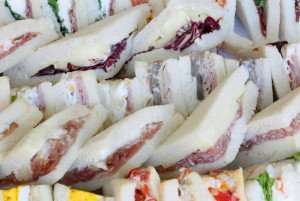 Tramezzino
TramezzinoThese aren’t the fanciest of snacks, but they get the job done! Imagine two pieces of soft, crustless white bread cut into triangles and filled with a variety of fillings: ham and cheese, mushroom and cheese, spinach, artichokes, tuna and egg…. There are dozens of varieties of tramezzini. It is served cold or toasted, as you prefer.
 Porchetta
PorchettaThis meaty filling is made of a deboned pig wrapped with salt, pepper, and herbs, and roasted slowly until it is perfectly tender. It is then sliced and served between pieces of Roman bread. Delicious!
This triangular-shaped snack was invented in 2008, so it is a relative newcomer to the scene of Roman street food. It is a cross between a tramezzino and pizza, with a triangular piece of crust stuffed with pizza fillings.
 Supplì
SupplìMy personal favorite, these fried rice balls are a cousin to the more famous arancini of Sicily. They are oval-shaped balls of tomato risotto with a mozzarella filling, breaded and fried. The original preparation included liver in the filling, but that is usually left out these days. They are also called supplí al telefono, because the mozzarella in the middle, when melted, forms long strings like telephone wire when you eat them. (Check out our recipe for supplì).
Where to try these wonderful snacks on our Roman culinary vacations? Tramezzini can be had in any neighborhood bar. For the best porchetta sandwich in Rome? If you can’t make it out of the city to the nearby town of Aricccia, Mecca to porchetta lovers, then head to Panificio Bonci near the Vatican, or to Er Bucheto near the Termini train station. For a taste of trapizzini, find them at their source in the Testaccio neighborhood.
Romans like their sweets just like the rest of Italy!
 Gelato
GelatoGelato is perhaps everyone’s favorite sweet in Italy, and there are plenty of amazing gelaterie to try on our Roman culinary vacations. I think the best gelateria in Rome is the Cremeria Monteforte directly to the side of the Pantheon. Order a cone with panna sotto e sopra (whipped cream “below and above,” that is, stuffed into the cone and also on top!). Another great gelateria is the one on Isola Tiberina.
 Tiramisú
TiramisúTiramisú is the classic Italian dessert featuring coffee, lady fingers, eggs, sugar, and mascarpone cheese. You will find it in Rome just as in almost every restaurant throughout Italy! (Check out our tiramisú recipe and make it yourself at home.)
Traditionally a Lenten food, maritozzi, a soft, oval-shaped yeasted bun stuffed with whipped cream, can now be found year round, and are especially popular as a breakfast food. The maritozzi found at Pasticceria Regoli near Piazza Vittorio Emanuele II are known for the virtiginous mound of whipped cream piled atop the buns.
What do Romans drink? That depends of course on the time of day.
 Coffee
CoffeeCoffee, or caffé, is a huge part of Roman life. Cappuccino in the morning, espresso (called simply “un caffé” in Italy) after every meal (and often between meals), perhaps a caffé corretto (with a shot of liquor or liqueur) to get you through the afternoon… Coffee in Rome is a must! Particularly famous is the coffee found in Piazza Sant’Eustachio at the cafe of the same name.
 Spritz
SpritzThe Sprtiz, originally from the Veneto region in northern Italy, has taken Rome by storm, and is a classic apperitivo that you can enjoy at almost any bar.
Of course, the main beverage of choice in Rome is wine. (Unless you are eating pizza, in which case beer is the beverage of choice!) We have written elsewhere about the wines of Lazio, all of which you can try on our culinary vacations in Rome.
Now that you know what you want to eat in Rome, where do you go from there? Check out these tips!

Breakfast in Rome is not like in the US. Usually Romans will stop at a bar for a cappuccino or un caffé (espresso), accompanied by a pastry such as a cornetto (croissant), which are always taken standing up at the bar. Even though hotel breakfast is included as part of our culinary vacations, you might want to try breakfasting like a Roman. It is a quick and fun way to experience the local culture!
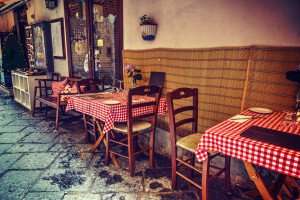 Lunch in Rome
Lunch in RomeLunchtime is a great time to explore your options. Many restaurants will offer a menú fisso (fixed menu) for lunchtime, which is a great way to get a multi-course lunch for less. But you might want to try pizza al taglio or one of the sandwiches we recommend if you want quicker and lighter fare.
 Finding a Restaurant
Finding a RestaurantBefore dining out in Rome, we recommend doing a little research. This might be reading our ultimate guide to food in Rome (your best resource!) or simply asking the concierge of your hotel for a recommendation. This is particularly important if you plan to dine near one of the main tourist sites like the Vatican, the Colosseum, or the Fontana di Trevi, where tourist traps are hard to distinguish from good, authentic Roman restaurants. Some restaurants will require reservations.
 When to Dine
When to DineWhat time do they eat dinner in Rome? Much later, in general, than we do in the U.S. Many restaurants won’t even open before 7:30 or 8:00 pm, and meeting friend for dinner at 9:00 or later is perfectly common. So when you are deciding what time to eat dinner in Rome, be sure to check opening times.
Coffee is not just a beverage in Rome, there is a whole culture around it, about which I have written at length elsewhere. It starts every day, ends every meal, and is a frequent visitor throughout the day!
 When you sit down to eat at a restaurant or trattoria, usually the waiter will bring bread for the table. This is not a free offering like you would find in the U.S., but is covered by a pane e coperto or simply coperto cover charge. Usually this is only a couple Euros per person.
When you sit down to eat at a restaurant or trattoria, usually the waiter will bring bread for the table. This is not a free offering like you would find in the U.S., but is covered by a pane e coperto or simply coperto cover charge. Usually this is only a couple Euros per person.
 Rome, incidentally, has wonderful bread. The most common bread in Rome is Pane di Genzano (or Genzano Casareccio), an IGP product that has been made in the village of Genzano (another of the towns of the castelli romani) for over 300 years. It was traditionally baked in communal, wood-burning bread ovens, and incorporates just a few ingredients (mother yeast, 0 or 00 flour, wheat flour, water, and, some say, the air of Genzano itself). It has a thick, dark, crunchy crust and a soft, spongy interior.
Rome, incidentally, has wonderful bread. The most common bread in Rome is Pane di Genzano (or Genzano Casareccio), an IGP product that has been made in the village of Genzano (another of the towns of the castelli romani) for over 300 years. It was traditionally baked in communal, wood-burning bread ovens, and incorporates just a few ingredients (mother yeast, 0 or 00 flour, wheat flour, water, and, some say, the air of Genzano itself). It has a thick, dark, crunchy crust and a soft, spongy interior.
Another classic Roman bread is the rosetta, a round, hollow white roll with a rose pattern on top. Rosette are commonly enjoyed at breakfast with jam, or are used in sandwiches, since their hollow shape and soft texture seem tailor-made for stuffing.
What are our favorite things to see in Rome?
If you are ready to get inspired, check out our video on dining out in Italy. Viewer warning: it may induce cravings!
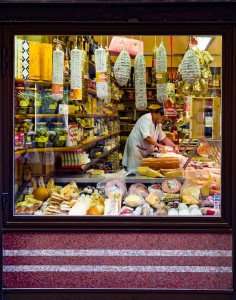 Arrivederci e a presto!
Arrivederci e a presto!Hopefully you are now ready to tackle the amazing food of Rome on a culinary vacation in Italy.
To explore the cuisine of the Lazio region, check out our cooking vacations in the countryside south of Rome and in the Sabine Hills, or reach out if you would like us to plan a custom culinary tour for you.
 If you are looking to get up close and personal with the food of Rome, we also offer one-day cooking classes, walking tours, and personal dining experiences in private Roman homes. Check out our cooking classes in Rome for details.
If you are looking to get up close and personal with the food of Rome, we also offer one-day cooking classes, walking tours, and personal dining experiences in private Roman homes. Check out our cooking classes in Rome for details.
Many of our culinary travelers also ask us to organize pre- and post-travel for them in Rome if they are participating in one of our Italy culinary vacations in Tuscany, Umbria, the Amalfi Coast, or elsewhere. We can create a custom stay including hotels, foodie tours, cooking classes, cultural tours, and museum visits. Contact us to start planning!
By Peg Kern
Find more photos, videos, food facts, and travel stories from The International Kitchen on Facebook, Instagram, Pinterest, Twitter, and YouTube.